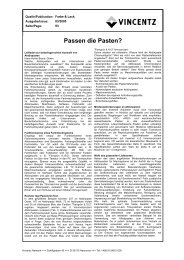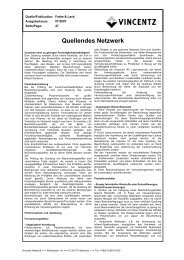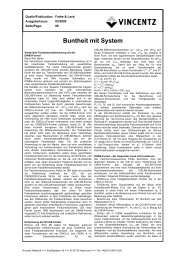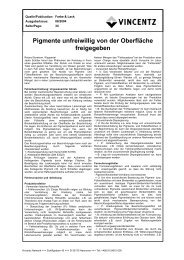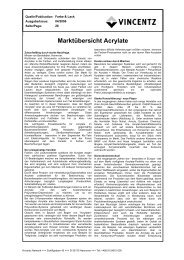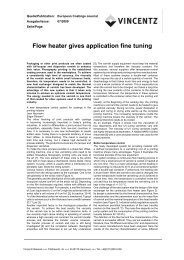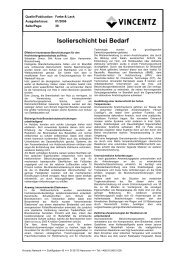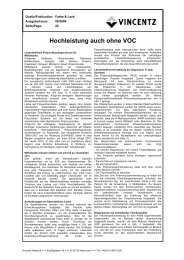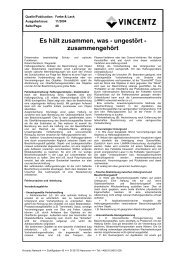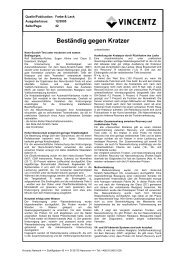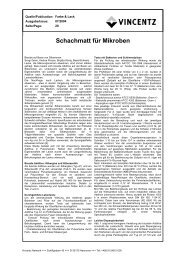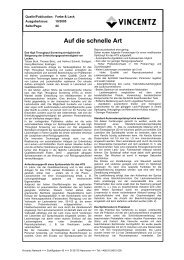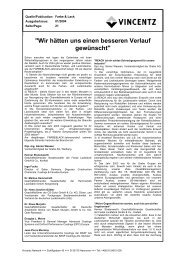High colour purity iron oxide red - European-coatings.com
High colour purity iron oxide red - European-coatings.com
High colour purity iron oxide red - European-coatings.com
Create successful ePaper yourself
Turn your PDF publications into a flip-book with our unique Google optimized e-Paper software.
Quelle/Publication: <strong>European</strong> Coatings Journal<br />
Ausgabe/Issue: 04/2004<br />
Seite/Page: 20<br />
<strong>High</strong> <strong>colour</strong> <strong>purity</strong> <strong>iron</strong> <strong>oxide</strong> <strong>red</strong><br />
Uwe Hempelmann, Volker Schneider.<br />
Derived via calcination of a special, near-spheroidal <strong>iron</strong><br />
<strong>oxide</strong> yellow precursor, a new <strong>iron</strong> <strong>oxide</strong> <strong>red</strong> pigment has<br />
been developed that features excellent <strong>colour</strong>istic as well as<br />
application properties.<br />
Although <strong>iron</strong> <strong>oxide</strong> pigments have been used in paints for<br />
many thousands of years and synthetic <strong>iron</strong> <strong>oxide</strong>s have<br />
been produced on an industrial scale for more than 75<br />
years, not all market requirements can yet be satisfied. In<br />
particular, the brilliance of <strong>iron</strong> <strong>oxide</strong> <strong>red</strong> pigments is<br />
restricted by natural causes and does not always meet user<br />
requirements. Thus, the optimization of <strong>colour</strong> <strong>purity</strong> offers<br />
scope for new developments.<br />
Particle shape determines the properties<br />
Many types of <strong>iron</strong> <strong>oxide</strong> pigment are available in three<br />
basic <strong>colour</strong>s: yellow, <strong>red</strong> and black. These have goethite (α<br />
-FeOOH), hematite (Fe2O3) and magnetite (Fe3O4)<br />
structures respectively and differ in their particle size and<br />
shape. Chemically speaking, the basic <strong>colour</strong>s are identical.<br />
The tint is largely determined by the mean particle size and<br />
the <strong>purity</strong> of <strong>colour</strong> by the particle size distribution width and<br />
the trace element content. The physical properties, e.g.<br />
influence on viscosity in pigment preparations, are largely<br />
dependent on the particle shape.<br />
Three synthesis routes are normally used in the<br />
manufacture of <strong>red</strong> hematite pigments:<br />
- Controlled oxidation of metallic <strong>iron</strong> in a two-stage process<br />
(Laux process) in which the first stage yields a magnetite<br />
intermediate which is then calcined to form the <strong>iron</strong> <strong>oxide</strong><br />
<strong>red</strong> end product;<br />
- Direct precipitation of α-Fe2O3 from <strong>iron</strong>(II) salt solutions<br />
under oxidizing conditions;<br />
- Calcination of <strong>iron</strong> <strong>oxide</strong> yellow pigments.<br />
To a certain extent, the synthesis routes also determine the<br />
properties of the pigments. The Laux process yields<br />
high-quality <strong>iron</strong> <strong>oxide</strong> pigments that <strong>com</strong>bine grinding<br />
stability, thermal stability and an isomorphic particle<br />
geometry. The almost cubic structure is associated with a<br />
relatively low viscosity in <strong>coatings</strong>. However, not all <strong>colour</strong><br />
loci can be achieved by this route.<br />
Hematite pigments manufactu<strong>red</strong> by the precipitation<br />
process typically display good <strong>colour</strong> <strong>purity</strong>. However, they<br />
are sensitive to grinding, i.e. the <strong>colour</strong> values change<br />
noticeably after intensive dispersion. Moreover, their thermal<br />
stability is often lower than that of pigments manufactu<strong>red</strong><br />
by processes in which temperatures exceed 600 °C.<br />
Calcined pigments retain the shape of their precursors<br />
Iron <strong>oxide</strong> <strong>red</strong> pigments manufactu<strong>red</strong> by calcining yellow<br />
pigments display several unfavourable characteristics<br />
associated with the hematite yellows used as intermediates.<br />
For instance, the typical acicular (needle-like) structure of α<br />
-FeOOH causes the much higher viscosity of <strong>iron</strong> <strong>oxide</strong><br />
yellow pigment preparations and highly pigmented <strong>coatings</strong>,<br />
and it also acounts for an optical anisotropy, which is<br />
responsible for the silking effect that occurs when a coating<br />
is applied by brushing.<br />
The acicular crystal structure of the yellow intermediate<br />
remains virtually intact after calcination (pseudomorphic<br />
transformation). Thus, the resulting <strong>red</strong> pigments also lead<br />
to a higher viscosity in pigment preparations and, to some<br />
extent, cause silking.<br />
<strong>High</strong>ly branched pigments lead to novel properties<br />
By modifying the manufacturing process it is possible to<br />
Vincentz Network +++ Schiffgraben 43 +++ D-30175 Hannover +++ Tel.:+49(511)9910-000<br />
produce highly branched primary particles that do not<br />
display the unfavorable characteristics of acicular pigments.<br />
One product manufactu<strong>red</strong> in this way is "Bayferrox 915", a<br />
yellow pigment. Figures 1 and 2 shows electron<br />
micrographs of two different yellow precursor pigments<br />
(Figure 1 a and b) as well as two <strong>red</strong> pigment test products<br />
(TP 1 and TP 2) manufactu<strong>red</strong> from these different yellow<br />
intermediates (Figure 2a and b).<br />
The influence of the different structure is revealed by<br />
<strong>com</strong>parison of the viscosity of pigment preparations<br />
containing various <strong>iron</strong> <strong>oxide</strong> pigments. Thus, the pigments<br />
were tested at a pigment concentration of 60% in a<br />
multipurpose shading paste. At this concentration, TP 2<br />
could not even be incorporated into the dispersion, therefore<br />
the maximum concentration of 51% was used. Table 1<br />
shows the findings for the two test products and three<br />
conventional pigments. The performance of TP 1 is almost<br />
equivalent to that of the products manufactu<strong>red</strong> by the Laux<br />
process.<br />
Table 2 and Figure 3 show the <strong>colour</strong> values measu<strong>red</strong> in<br />
an emulsion paint and in "Alkydal F 48", both for the full<br />
shade and for a 1:5 <strong>red</strong>uction with titanium di<strong>oxide</strong>.<br />
Compa<strong>red</strong> with the "Bayferrox" standards, TP 1 yields more<br />
saturated <strong>colour</strong>s, whereas the acicular TP 2 yields no<br />
significant improvement.<br />
Once product optimization and scale-up to full production of<br />
TP1 will be <strong>com</strong>pleted, preparations will be made for the<br />
market launch of the new product.<br />
Results at a glance<br />
- Existing standard <strong>red</strong> pigments obtained by transforming<br />
yellow pigments retain the unfavourable properties of their<br />
acicular intermediates.<br />
- A new test product TP 1 has been produced by calcination<br />
of a highly branched, almost spherulitic <strong>iron</strong> <strong>oxide</strong> yellow<br />
intermediate, which has been optimized for the subsequent<br />
transformation.<br />
- The new <strong>red</strong> pigment shows positive <strong>colour</strong>istic and<br />
application properties, <strong>com</strong>bining the <strong>colour</strong> <strong>purity</strong> and good<br />
dispersion properties of pigments manufactu<strong>red</strong> by the<br />
precipitation process with the positive characteristics of<br />
pigments produced by the Laux process and by calcination<br />
of yellow pigments, e.g. thermal and grinding stability, as<br />
well as low viscosity in pigment preparations.<br />
The authors:<br />
> Dr. Uwe Hempelmann, Bayer Chemicals,<br />
studiedchemistry at the University of Bielefeld, Germany. He<br />
joined Bayer AG in Krefeld-Uerdingen in 1989 to work in the<br />
field of inorganic pigments, especially <strong>iron</strong> <strong>oxide</strong>s. Within<br />
Bayer Chemicals AG he is now responsible for the<br />
application of <strong>iron</strong> <strong>oxide</strong> pigmented paints and <strong>coatings</strong> as a<br />
manager in the <strong>com</strong>petence center paint. Dr. Hempelmann<br />
is an active member of several national and international<br />
working groups in the field of pigments and extenders.<br />
> Dr. Volker Schneider, Bayer Chemicals, studied chemistry<br />
at the University of the Saarland, Germany, where he also<br />
obtained his Doctorate. He joined Bayer AG in 1988 as<br />
research manager in the <strong>coatings</strong> raw materials division,<br />
became technical marketing manager for concrete<br />
protection systems in 1995 and since 2000 has been<br />
technical marketing manager, <strong>com</strong>petence center paints, in<br />
the inorganic pigments group of Bayer Chemicals AG,<br />
responsible for the application of <strong>iron</strong> <strong>oxide</strong> pigments in<br />
paints and <strong>coatings</strong>.
Quelle/Publication: <strong>European</strong> Coatings Journal<br />
Ausgabe/Issue: 04/2004<br />
Seite/Page: 20<br />
To figure 1 a-b, PDF p. 3 and 4:<br />
Figure 1:<br />
Electron micrographs of a) an acicular yellow pigment<br />
("Bayferrox 3920"); b) a highly branched, almost spherulitic<br />
yellow pigment ("Bayferrox 915")<br />
To figure 2 a-b, PDF p. 5 and 6:<br />
Figure 2: Electron micrographs of:<br />
a) the <strong>red</strong> pigment TP2 yielded by calcination of the acicular<br />
yellow pigment shown in Figure 1 a);<br />
b) the <strong>red</strong> pigment TP1 with near-spherulitic structure, made<br />
by calcination of the yellow pigment shown in Figure 1 b)<br />
To figure 3 a-d, PDF p. 7 and 8:<br />
Figure 3: a* and b* <strong>colour</strong> values of "Bayferrox 110 M", "120<br />
M" and "130 M", and the two test products TP 1 and TP2:<br />
a) full shade, in an emulsion paint;<br />
b) <strong>red</strong>uced 1:5 with titanium di<strong>oxide</strong>, in an emulsion paint;<br />
c) full shade, in "Alkydal F 48"; d) <strong>red</strong>uced 1:5 with titanium<br />
di<strong>oxide</strong>, in "Alkydal F 48"<br />
Vincentz Network +++ Schiffgraben 43 +++ D-30175 Hannover +++ Tel.:+49(511)9910-000
Quelle/Publication: <strong>European</strong> Coatings Journal<br />
Ausgabe/Issue: 04/2004<br />
Seite/Page: 20<br />
Vincentz Network +++ Schiffgraben 43 +++ D-30175 Hannover +++ Tel.:+49(511)9910-000<br />
.
Quelle/Publication: <strong>European</strong> Coatings Journal<br />
Ausgabe/Issue: 04/2004<br />
Seite/Page: 20<br />
Vincentz Network +++ Schiffgraben 43 +++ D-30175 Hannover +++ Tel.:+49(511)9910-000<br />
.
Quelle/Publication: <strong>European</strong> Coatings Journal<br />
Ausgabe/Issue: 04/2004<br />
Seite/Page: 20<br />
Vincentz Network +++ Schiffgraben 43 +++ D-30175 Hannover +++ Tel.:+49(511)9910-000<br />
.
Quelle/Publication: <strong>European</strong> Coatings Journal<br />
Ausgabe/Issue: 04/2004<br />
Seite/Page: 20<br />
Vincentz Network +++ Schiffgraben 43 +++ D-30175 Hannover +++ Tel.:+49(511)9910-000<br />
.
Quelle/Publication: <strong>European</strong> Coatings Journal<br />
Ausgabe/Issue: 04/2004<br />
Seite/Page: 20<br />
Vincentz Network +++ Schiffgraben 43 +++ D-30175 Hannover +++ Tel.:+49(511)9910-000<br />
.<br />
.
Quelle/Publication: <strong>European</strong> Coatings Journal<br />
Ausgabe/Issue: 04/2004<br />
Seite/Page: 20<br />
Vincentz Network +++ Schiffgraben 43 +++ D-30175 Hannover +++ Tel.:+49(511)9910-000<br />
.<br />
.
Quelle/Publication: <strong>European</strong> Coatings Journal<br />
Ausgabe/Issue: 04/2004<br />
Seite/Page: 20<br />
Vincentz Network +++ Schiffgraben 43 +++ D-30175 Hannover +++ Tel.:+49(511)9910-000<br />
.
Quelle/Publication: <strong>European</strong> Coatings Journal<br />
Ausgabe/Issue: 04/2004<br />
Seite/Page: 20<br />
Vincentz Network +++ Schiffgraben 43 +++ D-30175 Hannover +++ Tel.:+49(511)9910-000<br />
.



